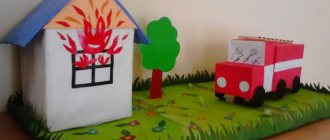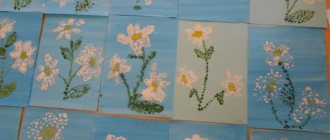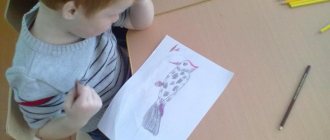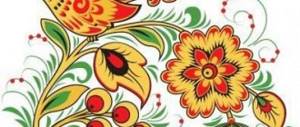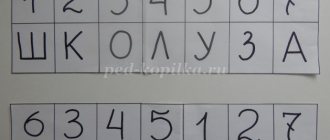Specific options within the theme “Birds”
According to T. Komarova’s fine arts program, in the preparatory group two lessons are devoted to drawing birds: this is drawing an illustration for the work of Mamin-Sibiryak “The Gray Neck” and “The Magic Bird”. However, the topic of birds is so interesting and multifaceted that the teacher clearly should not limit himself to only this. So, options for the feathered theme could be as follows:
- Owl-owl (a very bright image that can be depicted in different techniques).
- A flock of migratory birds (theme is proposed in autumn or spring).
- Cockerel is a golden comb (can be associated with some fairy tale, for example, “The Cockerel and the Bean Seed” or “The Tale of the Golden Cockerel” by A. S. Pushkin).
- Titmouse (you can draw on November 12 or not far from this date, when people celebrate Titmouse Day).
- Bullfinches on a branch (of course, this theme is offered in winter).
- Swallow (it’s good to connect the image with the fairy tale “Thumbelina”).
- Poultry (poultry yard as an option). A child can simultaneously portray a chicken, a rooster, a duck, a goose, a turkey, or one or the other.
- White-sided magpie.
- Swan on the lake (as a variant of the swan princess of A.S. Pushkin before her transformation into a girl or an illustration for Andersen’s fairy tale “Wild Swans”).
- Kargopol birds (drawing based on folk toys).
- Fairytale bird (Firebird).
Older preschoolers always find collective compositions interesting. The “Magic Bird” work is popular, when each child paints a feather to his own taste, and then a gorgeous tail is assembled from them (the teacher prepares the base in advance - the body of the bird).
Each child paints the feather according to their wishes, and together they make up the original tail of a fairy-tale bird.
Here again, you can take an individual approach and invite some children to color two feathers.
Another option for joint creativity is “Birds at the feeder.” The teacher draws a tree with branches and a feeder, and preschoolers complete the composition with birds.
The theme “Birds” encourages the creation of collective compositions
Preparing for a drawing lesson in the preparatory group of a kindergarten.
Classes in visual arts (drawing, designing and modeling) are held with pupils of the preparatory group three times a week. For modeling and appliqué, classes alternate and are held once every two weeks, for drawing - two classes every week.
Drawing lesson in the preparatory group
As a rule, drawing is one of the favorite types of creative activity among children. The process of creating a visual image using simple actions brings positive emotions. The children master basic techniques and techniques and show great independence in drawing. When developing a work program for drawing in the preparatory group, it is necessary to comply with the criteria for conducting classes with children aged 6–7 years:
- Using the children’s existing work experience with the obligatory involvement of something new. Consolidation of drawing skills occurs with the creation of each subsequent drawing, but at the end of the lesson, students should have an answer to the question: “What have you learned today?” Various forms and methods of using existing abilities stimulate children’s interest in creative activities. For example, students in the preparatory group know basic colors and shades, have an idea of color combinations, and know how to mix gouache and highlight watercolors. Based on these children's drawing skills, the teacher teaches them to see the beauty of the color diversity of the world around them and convey what is visible on a sheet of paper with smooth transitions and accents. The guys know how to hold a brush correctly and carefully draw lines and paint over contours; they know different ways of painting with a brush: the whole bristle, the tip, pokes, and applying individual strokes of different thicknesses. But they need to be taught to draw with colored pencils. In the preparatory group, children learn to carefully cover the contours of pencil shading, using varying degrees of pressure.
- Learning to follow verbal instructions and predict actions. Direct demonstration as a method of work is not carried out by the teacher in the preparatory group (the only exception is for the first experience of drawing with new materials - pastels, sanguine, chalk, as well as individual demonstration for those who have difficulties in completing the task). An action plan for drawing an object or plot, and specific practical techniques are discussed with the students. At the age of 6–7 years, children can independently reconstruct the stages of drawing a sample of the finished work shown to them according to the assignment.
- Developing your own idea. Older preschoolers are given maximum freedom in thinking through the image for the drawing, materials and techniques that are needed for visual implementation.
- Play is still the main activity for children, so drawing techniques should be taught with the active use of game forms. The teacher should include surprise and game elements during the lesson based on the established topic.
Drawing lesson in the preparatory group
In the senior group, the children got acquainted with three types of drawing: subject, subject and decorative. In the preparatory group, great importance is given to drawing from ideas. Pupils work with visual memory images, analyze demonstrated illustrations and other visual materials. Classes on the topic “Birds” do not involve consolidating and honing the skill of drawing from life. The guys look at images of birds on pictures and posters, the teacher pays attention to the birds during a walk - the guys highlight the characteristics of different types of birds (size, shape of head/body/beak, colors and shades in plumage) and record their characteristic movements: a bird sat on a branch , takes off, pecks berries, swims, etc. According to the presentation, the children also draw images of fairy-tale birds (Firebird, Finist).
Conveying these movements in simple actions is the main task of plot drawing in the preparatory group. The children transfer their feelings from the surrounding reality onto a piece of paper and depict semantic connections between objects and objects. On the topic “Birds,” students think through the plot point, try to fill the entire area of the sheet with an image, keeping in mind the perspective (near objects are drawn lower on the sheet, distant objects are drawn higher).
The theme “Birds” is also revealed in decorative drawing by older preschoolers. These are conventional images of birds as part of a complex pattern for decorating a plate, box, cutting board, tray and other items. Children can draw birds based on Gorodets, Khokhloma and Gzhel paintings, Filimonovskaya, Dymkovo and Bogorodskaya toys.
Samples of works on the topic “Birds”, made in various drawing methods.
Example of subject drawing
Example of plot drawing Drawing based on the characters of a fable
Example of drawing by representation
Decorative drawing based on Khokhloma painting
Decorative drawing based on Gzhel painting
Decorative drawing based on the Dymkovo toy Decorative drawing based on the Filimonovskaya toy
Techniques and techniques of drawing in the preparatory group.
During drawing classes, older preschoolers create works not only with paints, but also with pencils. At the age of 6–7 years, a child can perform uniform bright shading with slate and wax colored pencils. It can achieve different shades of the same color in a pencil drawing (due to the intensity of pressure during the shading process). Using a simple pencil, the child learns to create a preliminary sketch: he outlines the contours of an object without drawing individual elements. To clearly highlight the contours and details of colored objects, colored felt-tip pens can be used.
Pencil drawing of a preparatory group student
When painting with paints, older preschoolers practice the skills of mixing and whitening paints on a palette to obtain the desired colors and shades. In the preparatory group, the children use the techniques of dabbing and brushstrokes in their work, painting both with the entire bristle of the brush and with the tip.
Watercolors are often used in art classes. By drawing with slate pencils or watercolors, children learn to see the beauty of light shades. Over the entire area of the sheet, students paint a blurry background with watercolors.
Watercolor drawing by a preparatory group student
Gouache is used in decorative drawing or in the creation of those subject and subject works in which, according to the plan, color is applied to color.
Gouache drawing by a preparatory group student
As a basis for the drawings, sets of white and colored paper, special for watercolor and gouache, and Whatman paper are used (usually for creating collective works or implementing creative projects). Tinted paper is rarely used for work, mainly to create a decorative pattern based on folk painting. In subject and subject drawing classes, children learn to create a background on their own (plain or with smooth transitions).
On the topic “Birds,” classes are conducted using non-traditional drawing techniques: wax crayons with sketches in watercolor paint, cotton swabs, chalk on sandpaper, scratching techniques, monotype, etc.
Examples of bird drawings made using non-traditional techniques.
Examples of works using the finger painting technique
Drawing using the scratch technique Drawing using the scratch technique
An example of work using the grattage technique (with a colored background painted on the base)
Drawing using printing technique Example of blotography
An example of monotype in a child's drawing
Work in the monotype technique Work in the pointillism technique (drawing with cotton swabs)
Drawing on the topic “Birds” in the preparatory group can be combined with other visual arts techniques - appliqué and modeling. The guys complement dried watercolor and gouache drawings with details or figures according to the plan. For example, in a drawing of a tit, you can use pencils to glue grains molded from plasticine or crumpled pieces of napkin as “bread crumbs.” It is good to complement the image of the branch on which the bullfinch sat with plasticine rowan berries. The materials for creating the applique in the drawing can be varied: cotton pads, napkin balls, natural material, cut out motifs from candy wrappers and magazines. The use of plasticineography is encouraged - an unconventional drawing technique by smearing plasticine. Plasticine strokes help to beautifully and originally design the background of the picture: the sky, a clearing, tree leaves or snow on a branch.
Examples of drawings of birds in combination with other iso-techniques.
The berries are made using the technique of crumpling paper elements
The drawing is supplemented with plasticine elements
A combination of drawing and appliqué techniques
Combination of drawing and appliqué techniques (team work)
Complementing the drawing with plasticine elements Drawing with paints with plasticine elements
Mixed media (drawing and applique)
Individualization of tasks on the topic “Birds” in the preparatory group.
An individual approach to learning is implemented through a personal approach to students, the development of differentiated tasks (by level of difficulty or by design) and the setting of classes not for the “average student”, but for the development of the skills of each child in the group. For drawing classes in the preparatory group, this approach is carried out through the teacher’s adherence to the following principles and methods of work:
- Knowledge of the individual psychological characteristics of each student. The teacher must know the characteristics of attention and memory, the degree of proficiency in one or another skill, the desire to work in a group or separately for each child. Directly during the lesson, the teacher must pay attention to the emotional state of the students: enthusiastic and active children should receive a more difficult task, and those who are unsure of their abilities or are in a bad mood for some reason are given the task they can do. Options for tasks for high-achieving students: complete the drawing with plasticine elements (rowan berries, bird eyes, leaves on a branch); decorate the work with applique (tree trunk, grass, flowers) or natural material (leaves, twigs); work on the background in detail or using the plasticine technique (drawing grass, tree crowns, clouds, sky and sun with plasticine strokes).
- Stimulating cognitive activity, the desire to share one’s own experiences and examples from life with others. For example, in a lesson on the topic “Titmouse,” the teacher can ask when and where the children saw these birds. Did they feed them? Did you make feeders for them (with parents or in younger groups)? At the beginning of the “Poultry” lesson, it is recommended to have a conversation: which of the children is going out of town on vacation, have they seen a poultry yard, what kind of birds are kept in the villages; who has parrots, canaries or other ornamental birds at home, what features do they have (plumage, vocalizations).
- Freedom of creative idea and its implementation. Children aged 6–7 years actively analyze the work ahead of the assignment and think through the stages of creating a drawing. The teacher should not limit the imagination of the pupils, but direct it in the right direction. Children should be given access to a rack/cabinet with brushes, paints, pencils, tools for non-traditional techniques, and materials for sculpting and appliqué.
- Creating conditions and situations (game or problem) for students to demonstrate their abilities. In the game, children learn to correctly determine the relationships and connections between objects and phenomena of the surrounding world. Children aged 6–7 years play, having previously thought through the plot of the game, jointly distributing roles and the course of the game. When solving problem situations, the teacher should encourage children to actively share personal experiences and examples from life, express their opinions, visions of the situation and solutions. The teacher needs to instill in children the desire to speak openly, engage in discussion and analyze the ideas of others reasonably. Examples of logic games on the topic “Birds”: find identical pictures of birds, trace the outline and name the bird, draw the characteristic pose of the bird yourself, recognize the bird by its silhouette, reduce the image of the bird (draw a similar silhouette of a bird in a smaller size). In problem situations for preschool children, there should be a practical solution (give the answer and draw, show the character a bird, make a picture as a keepsake for a guest).
In drawing lessons, a person-centered approach is implemented through the teacher’s careful development of a lesson program and preparation for each lesson. By consolidating previously acquired skills in the process of creating a drawing, the child feels the significance of what he did previously. At every lesson he learns something new or learns something - the child has interest and incentive to develop. He analyzes the finished work, learns to accept constructive criticism and well-deserved praise.
The topic for a drawing lesson should be general and give each student the opportunity to dream up. For example, the topic “Poultry” can provide children with scope for creative activity based on the following criteria: what kind of bird to depict (the bird lives in an apartment or in the courtyard of a village house), perform work within the framework of subject drawing or plot drawing, choose the level of background detail, etc. For each drawing, children independently choose the color scheme in which they will draw (warm or cool colors), they can use additional materials to complement the work with modeling or paper appliqué, if there is time left after completing the main task.
The topic “Birds” in long-term planning for drawing in the preparatory group.
In the “Drawing” section of the program in the educational field “Artistic and Aesthetic Development” in the preparatory group, the topic “Birds” is presented in many classes. It is revealed when learning to draw from imagination, drawing images of folk tales and works of art, and decorative drawing.
| Lesson topic | Form of organizational activity | Training and development tasks | Techniques used |
| "Migratory birds" | Individual. | Teaching subject drawing based on idea (drawing certain types of birds, depicting the characteristic features of the shape of the bird’s body, head, beak, plumage). | Creating a pencil sketch: highlighting simple geometric shapes in the bird's structure. Coloring the body and head of the bird without going beyond the contours of the sketch. Drawing with individual strokes of plumage. Drawing with the tip of the brush individual details of the image (bird's legs, beak, eyes, tail, crest). |
| “Migratory birds are flying”, “Birds are flying south” | Individual/collective. | Teaching plot drawing depicting the characteristic movements of birds (movements in flight). | Developing the skill of creating a preliminary sketch. Creating a background (sky; possibly drawing a horizon line). Development of composition skills and simple perspective (the further away the bird is in design, the higher its image is located on a sheet of paper). Strengthening the techniques of painting with paints. Developing the ability to work in a subgroup. |
| “Illustrations for the fairy tale by D. N. Mamin-Sibiryak “The Gray Neck”” | Individual. | Formation of the ability to choose an episode for drawing a plot scene, to create images of a work of art. | Creating preliminary sketches when drawing complex figures (duck, fox, hunter). Drawing with paints, painting over the contours of a sketch, working out small details with the tip of a brush according to plan. |
| "Poultry" | Individual. | Development of the ability to draw from imagination (image of various types of poultry with their characteristic features). | Hatching with colored pencils with varying degrees of pressure. Creating outlines with felt-tip pens. |
| "Poultry yard" | Collective. | Developing interest in collective activities. Formation of the ability to draw plot scenes. | Development of drawing skills with pencils or paints. Developing the ability to work in a group: jointly thinking through the plot for the image and the background for the drawing, discussing and choosing a drawing technique (possibly involving appliqué or design with natural materials), analyzing the finished work. |
| "Magic Bird" | Individual. | Formation of the ability to draw fairy-tale images. | Consolidating the skill of drawing with colored pencils/Developing the skill of drawing with pastels or sanguine. Development of compositional abilities. |
| "Swan" | Individual. | Development of drawing by representation. Development of the ability to create images of a work of art (for the version of the theme “The Swan Princess”). | Creating a non-solid background. Drawing with gouache on a wet background. Working out small details with the tip of the brush. |
| “Illustrations for the fairy tale “Geese and Swans”” | Individual. | Development of the ability to create fairy-tale images in drawing. | Strengthening the skill of drawing with colored pencils. Create a detailed background. |
| "Magpie-white-sided" | Individual. | Development of the ability to draw a bird in a certain pose according to an idea (a bird sitting on a branch). | Drawing with colored pencils based on a preliminary sketch. An exercise in arbitrarily pressing a pencil to obtain the desired color intensity. |
| "Owl Owl" | Individual. | Developing the ability to work in mixed media. | Drawing in watercolors from a preliminary pencil sketch. Drawing a contour line of individual parts with a black capillary pen. |
| “Goose”, “Titmouse”, “Swallows”, “Bullfinches on a Branch”, “Sparrows” | Individual. | Development of the ability to draw the figure of a bird in a constructive way (using simple geometric shapes). | Creating a sketch with a simple pencil in a constructive way. Strengthening the skill of drawing with pencils/watercolors/gouache/pastels. In topics on drawing individual types of birds, it is recommended to teach drawing in mixed media. |
| "A Flock of Sparrows" | Collective. | Development of the ability to draw a bird in a certain pose (pecking crumbs/grains). | Drawing with colored pencils with varying degrees of pressure, varied shading (imitation of plumage). Developing the ability to work harmoniously in a subgroup. Activation of imagination in thinking through the details of the drawing (what sparrows peck and how to depict it). |
| "The Golden Cockerel" | Individual. | Development of the ability to draw an image based on a work of art. | Creating a pencil sketch in a constructive way. Drawing with gouache. Consolidating the skill of obtaining different shades by mixing paints. |
| "Kargopol Birds" | Individual. | Development of the ability to draw objects from life (drawing the Kargopol toy “bird”). Development of decorative drawing skills. | Drawing with a simple pencil from life (figurine of a bird). Creation of a decorative pattern in gouache based on Kargopol painting. |
Photo gallery: examples of children's work on the topic “Birds”
The image of the Firebird is conveyed very elegantly - with a combination of yellow and orange colors
The poking method allows you to convey the fluffiness of a swan
The background is very beautifully designed - the sky
The multi-colored image of the cockerel echoes the variegated flowers with petals of the same tones
Bright colors combined with unconventional techniques give an original result
The plot composition has many characters
Pencil produces soft pastel colors
Subject compositions are often easier to depict with pencils
The black and yellow titmouse looks beautiful against the background of blue snow
The fairytale bird looks more like a small chick hiding in a pine branch
You can unusually convey the loose tail of almost any bird with your palm
Future schoolchildren learn to draw sitting birds
The image of an owl encourages the use of unconventional techniques
Using foam rubber, the shaggy plumage of an owl is well conveyed
The owl's plumage is originally rendered in the form of brown zigzags on a yellow background.
The images of sparrows pecking grains are conveyed very realistically
Beautiful subject composition, gives the impression of birds moving
Children usually love to portray living creatures, especially those that they can observe in nature. That's why the theme "Birds" is always popular with preschoolers. Many pupils of the preparatory group are able to accurately notice the characteristic features of different birds and convey them through drawing, harmoniously building a composition. The main thing for the teacher is to captivate the students, motivate them to be creative, and provide some interesting information that will additionally awaken interest in birds.
